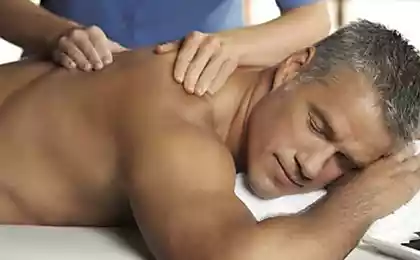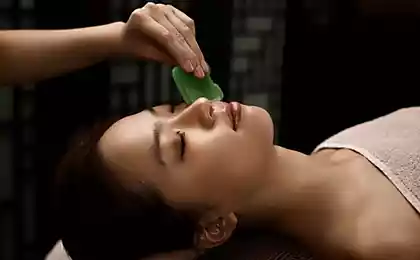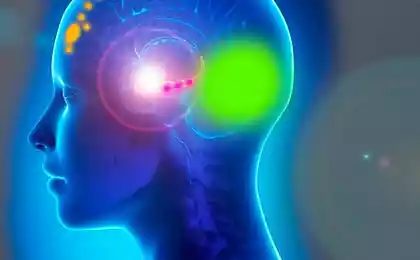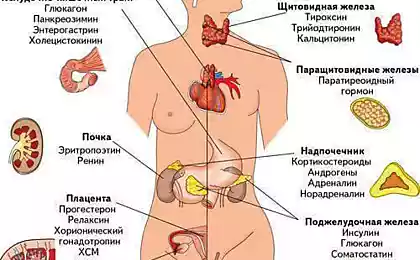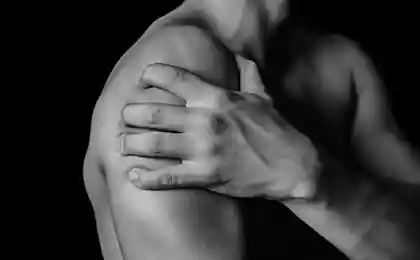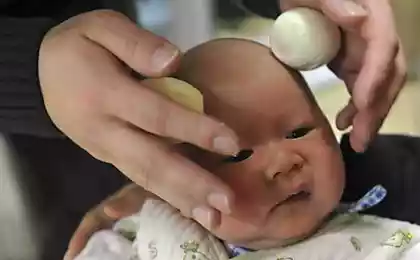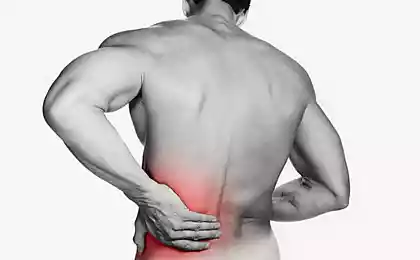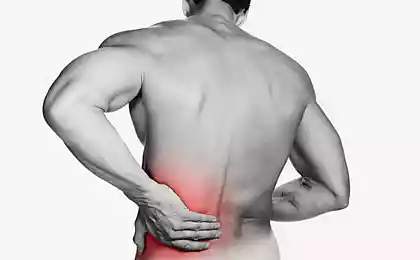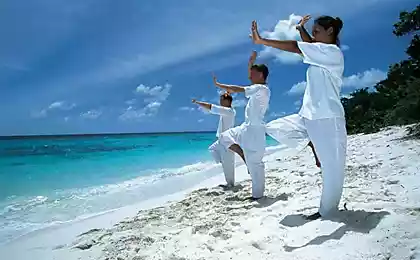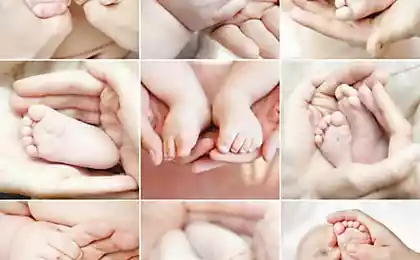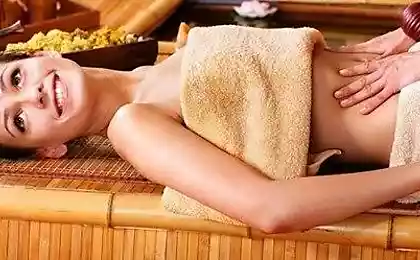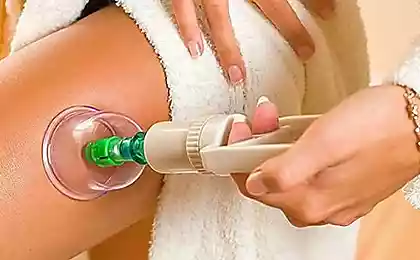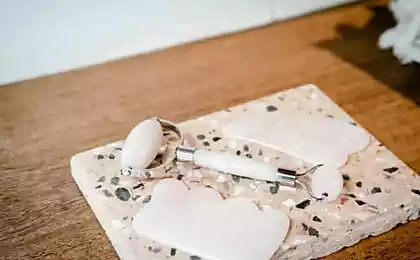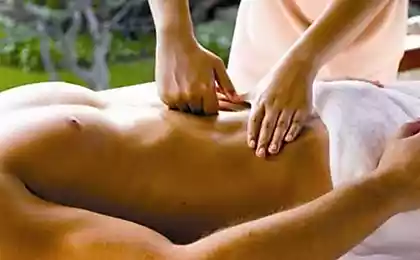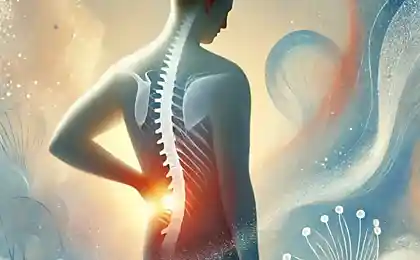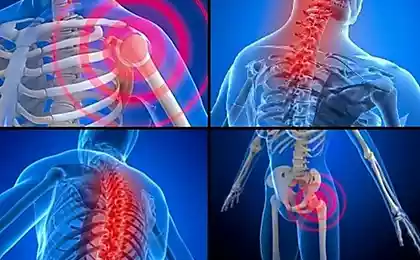345
Osteochondrosis - payback for not understanding your own body
A healthy spine is a happy lot.
Back pain is quite a frequent phenomenon in the life of each of us. But the statistics of visits to the doctor about osteochondrosis are small - only up to 20% of potential patients. As a rule, they come already when it becomes completely unbearable, although 85 percent of the world's population suffer from osteochondrosis.
As the ancients said, knowing the name of the enemy, it is easier to defeat him. And that this osteochondrosis is the enemy of the human race, no one doubts.
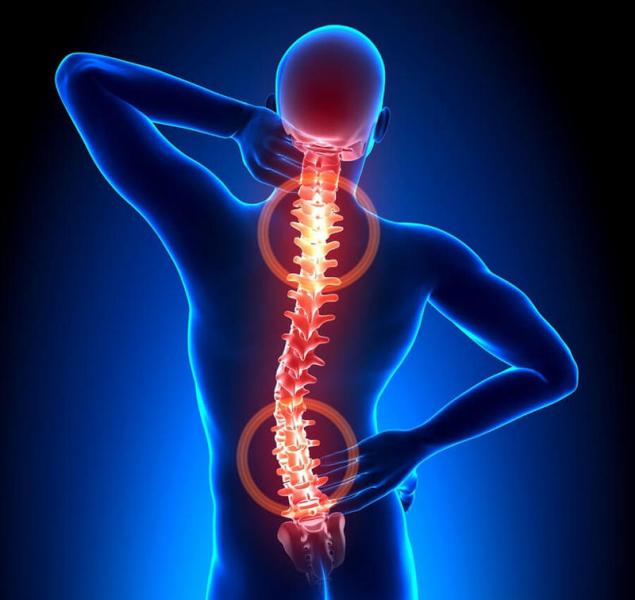
Osteochondrosis is a commercial diagnosis and has nothing to do with spinal pain.
As soon as they called osteochondrosis: a shot, he radiculitis, deposition of salts, or, as a due tribute to medical propaganda, acute chondrosis. Or rheumatism.
But it's not rheumatism. What then? The real name of the disease is osteochondrosis. And he's always chronic. Osteochondrosis translated from the Greek osteon means “bone”, hondros – “cartilage”, and the end of “oz” indicates the dystrophic nature of changes in these structures. You get bone and cartilage disease. The scientific definition of osteochondrosis of the spine sounds like this: osteochondrosis of the spine is dystrophic changes in the intervertebral disc and the vertebral bodies adjacent to it. Otherwise, osteochondrosis is a change caused by a violation in the disk of metabolic processes, that is, nutrition..
Osteochondrosis (Dystrophic changes in cartilage and adjacent bone) This is not a disease, but a sign of ageing. - the same as wrinkles, baldness and gray hair.
Osteochondrosis can not be the cause of back pain – bones, cartilage, spinal cord and brain do not have pain receptors. Therefore, their damage does not give pain symptoms.
Osteochondrotic growths also can neither damage nor "pinch" the roots and nerves - there are no roots outside the spinal canal, inside it they easily move into the cerebrospinal fluid, leaving compression.
In osteochondrosis, intervertebral discs - special cartilage structures that provide our spine with flexibility and mobility, become defective. That's where it starts.
There is a widespread belief that the cause of osteochondrosis is the deposition of salts in the spine: allegedly, salts are visible on X-rays in the form of “growths” and “hooks” on the vertebrae. If the movements in the joints are accompanied by crunching and creaking, as if sand is poured between them, many patients associate this with the notorious "salt deposition." Such misconceptions are by no means harmless: the correct idea of the treatment of the disease is formed on the basis of an analysis of the causes that caused it.
Causes of Osteochondrosis of a Caller
There are many theories of the development of osteochondrosis, in each of which, the main factor is one or another cause of osteochondrosis as, for example, hereditary predisposition, mechanical trauma, metabolic disorders, etc. It is especially difficult to determine the cause of osteochondrosis due to the fact that this disease occurs in both the elderly and young people, and at the same time in well-built and vice versa.
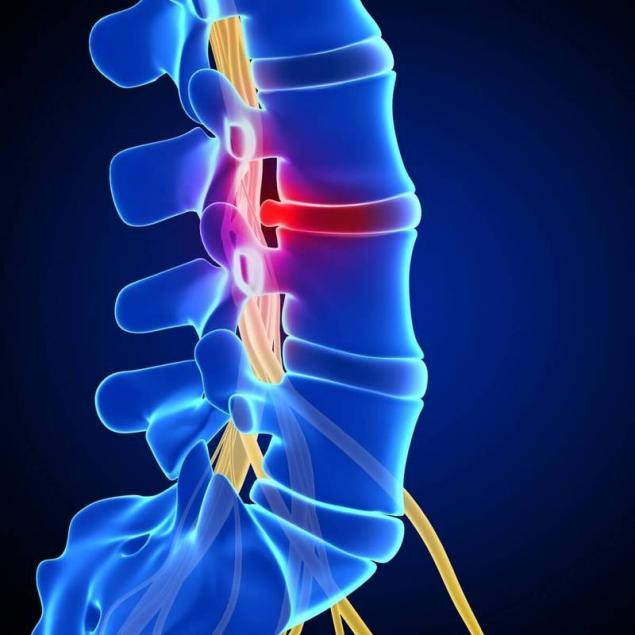
But walking upright alone could not cause osteochondrosis. Osteochondrosis is accompanied by spasm and hypertonus of the spinal muscles. Muscle spasms pinch the blood vessels that feed the spine, this disrupts the blood supply and nutrition of the intervertebral discs and nerve tissues of the spinal cord and its branches. In addition, spasm muscles tighten the spine, creating an additional load on the intervertebral discs. Discs “flatten”, losing depreciation properties. Over time, this leads to the protrusion of the discs beyond the spinal column, prolapse, and then rupture of the fibrous ring, loss of the disc nucleus and the formation of an intervertebral hernia.
Excess weight, which additionally pressures the spine. Against the background of excess weight, osteochondrosis of the lumbar spine most often occurs.
As a rule, it is associated with natural aging of the body (in particular, progressive dehydration), but it can occur at a young age.
The reason for the aging of living matter is the violation of its nutrition. It's an axiom. Remember how nutrients get into human organs and tissues. Through the arteries, blood enters the tissues, giving them oxygen and nutrients, and through the veins comes out, carrying away unnecessary metabolic products. The spine also includes arteries, and veins come out. But if blood enters the bodies of the vertebrae from the common bloodstream, then the disc - from the bodies of the vertebrae through the vessels connecting them. That is, the vertebrae are mediators in the blood supply between the discs and the entire body.
However, usually by 10-15 years there is a complete emptying of most of the vessels that connect the vertebrae to the disc.
Then the body turns on its reserve mechanisms, so that the rather intensive exchange of liquid media between them continues. But the metabolism is no longer carried out through the vessels, but through diffusion. It saves the disc, but not for long. A force is relentlessly pursuing him. The system is still working, providing power to the disk, but all with great voltage.
And then there's something that's between the disc and the vertebrae that's visibly disrupting the connection between them. This is a disaster. The pulp nucleus is breaking down. And this happens in 20-25 years. Age, look, very young.
Paradoxically, many athletes suffer from back pain, despite a good muscular corset and regular exercise.
Indeed, if the movements of the vertebrae in relation to the disc acquire a dangerously large amplitude, then in the places of their contact there are foci of traumatic injury. After all, the fibrous ring has to be restrained from excessive movement of the vertebrae. Its fibers are overstretched, sometimes torn, involving the process and edge plates. In response to damage, the body responds with inflammation.
At first, it is a transient edema of damaged tissues. In the future, as the outcome of inflammation, foci of connective, that is, scar tissue are formed in the closing plates and in the disk at the place of its contact with the vertebra.
With each traumatic movement, such scars become more and more. First one, then two, three, five... After a few years, there will be so many of them that radiologists, describing pictures of such a spine, will point to sclerosis of the closing plates.
It is the sclerosed closing plates that are the “foreign” body that closes the lumen of the vessels, and then creates an obstacle to the circulation of fluid through diffusion. Therefore, the intervertebral disc, “blocked” from above and below by sclerosed plates, gradually reborn. And here, unfortunately, no drugs or “miracle” treatments can help him. Here is a sad example of the victim of physical labor or mindless passion for sports.
Fighters with many years of experience (most of the patients with arthrosis are people over 40 years old) eventually acquire spondyloarthritis - damage to the joints of the spine, mainly in the cervical region.
For tennis players, rheumatologists even have a special term – “tennis elbow”. Due to sharp strong movements of the same type, they often suffer periarticular soft tissues of the elbow joint of the active hand.
That is, because of pain or curvature of the spine, a person begins to adapt to changes, changing the gait, posture when sitting or standing. This can be observed with prolonged static load, for example, regular sitting in the wrong position, when working at a computer, when working in a forced position, when practicing certain sports, etc.
Excessive physical activity - simultaneous or constantly recurring - is especially dangerous for those who have any deviations from the norm in the structure of the supporting structures of the spine.
For the same reason, many kilometers of running is harmful - vibration, concussions, a strong increase in pressure on the articular surfaces due to the sharpness of movements. However, it is unambiguous to say that running for one kilometer - heals, and for two - already cripples, it is impossible - the physical resource of cartilage in each person is individual. But, planning a ten-twenty-kilometer Sunday run, apparently, we need to think – is it worth it?
However, physical activity is not the only mechanism that leads to malnutrition of the intervertebral disc. And we understand the irritation of supporters of an active lifestyle. Indeed, why is osteochondrosis so common in knowledge workers? Just the desk, the bills and the pen. Where does he come from - osteochondrosis? It turns out that there is a violation of metabolic processes, but only for another reason.
It leads to a weakening of the muscle frame that supports the spine, and at the same time provokes stagnant phenomena in the back. As a result, blood circulation and nutrition of spinal tissues (intervertebral discs) are disturbed.
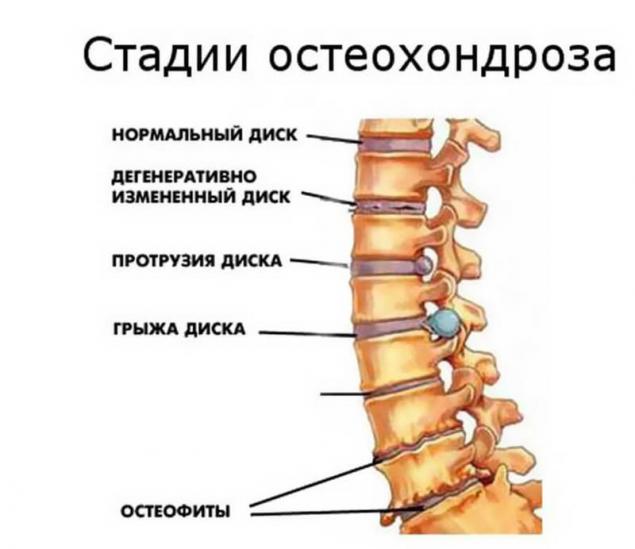
With a sedentary lifestyle, the small veins connecting the discs to the vertebrae are often clogged with clots. The danger of a sedentary lifestyle is also prolonged tension of the deep muscles of the back. What helps an office worker stay in a sitting position for several hours? What keeps his body in that position? Muscles. And above all, the deep muscles of the spine or back.
So, their prolonged tension is fraught with unpleasant consequences for the spinal column in general and for its discs in particular. Why?
Well, imagine how the intervertebral disc will feel, squeezed by the bodies of adjacent vertebrae, which are tightened by shortened muscle bundles. I think it's very uncomfortable. Moreover, vessels pass through the muscles. With prolonged muscle spasm, the existing venous stagnation will worsen even more. Due to the alternate reduction of the deep muscles of the back, the movement of venous blood from the spine occurs in the direction of the general venous vascular network.
Blood runs through the arteries thanks to a heart push, and cardiac output no longer has a significant effect on the movement of venous blood. Because the speed of blood flow is extinguished by a small network of capillaries connecting the arteries and veins. And the role of the vein pump is performed by the muscles. This is why people with inconsistency of the valves of the deep veins of the lower extremities swell their legs during prolonged sitting or, especially, standing. When walking, the swelling does not occur or is expressed much less.
Violation of venous blood flow contributes to the formation of blood clots in the veins that connect the vertebrae to the discs. As a result, the veins are empty, sclerosis. High pressure in the stagnant venous bed of the vertebral bodies prevents diffusion processes. Again, the disk power is disrupted. In addition, the constant compression of the disc by vertebrae tightened by tense muscles also makes blood flow difficult. Only in this case, the communication “disk – vertebra” is broken, and “vertebra – disc”.
Vessels do not work, diffusion processes are difficult. Nutrients do not arrive, unnecessary metabolic products are not removed from the disk. It's a nightmare. What's left for the poor disc? It's inglorious to rest. And the first “leaves” its more vulnerable part – the pulpous nucleus. That's when we start talking about the first stage of osteochondrosis.
“In addition to the above, osteochondrosis can occur against the background of spinal curvature, flatfoot, injuries and bruises of the spine, prolonged malnutrition. Therefore, all the same, osteochondrosis is a payment for improper exploitation of the body or, as it is now customary to say, for the wrong lifestyle.
Osteochondrosis is not a disease. This is the price of misunderstanding and ignorance of your own body.
Osteochondrosis is only structural changes, it is the state of the spinal column, nothing more. We call osteochondrosis a disease when its various manifestations – pain, muscle weakness, etc. – complicate a person’s life, negatively affect his performance.
Pain. It is she, being the most characteristic and often the only manifestation of osteochondrosis, significantly darkens the life of the sufferer of this disease. It is this that most often causes a person to consult a doctor. Those who suffer from pain in the spine and do not receive effective help from the attending physician are sometimes ready to grab any straw so that these sufferings only stop. Wanting to get rid of pain, a person often tries all imaginable and unthinkable types of treatment, spends a lot of time, effort and money in search of his doctor or “effective” medicine that would help him feel healthy again.
Therefore, the number of painkillers for back pain is growing, probably because the immediate relief from back pain by most specialists has become considered a cure for osteochondrosis. And although in the future there are relapses and people experiencing them are forced to wear various kinds of corsets and follow the recommendations of doctors to limit physical activity, this approach to the matter for some reason began to suit the majority. Don’t you want to get rid of this pain forever?
Of course, everyone has the desire. We want a lot out of life. We want for ourselves and our loved ones, our friends and enemies. But why aren't we doing it?
And the problem is one, little desire needs to be done. A simple thought or picture in your head cannot move you to a country house with a swimming pool or cure osteochondrosis. To do this, you need to act and not rely on a doctor only.
But you still ask, "Why did this happen?" Why am I so weak? “Because you don’t have muscle anymore.” - But I'm an athlete! Professional skier! Why did my muscles disappear? “Because you stopped skiing a long time ago.” That's how you get osteoporosis. The health of the spine largely depends on the endurance of the muscle-ligamentous apparatus or, in other words, the muscular-ligamentous corset. The stronger and more enduring the muscles and ligaments, the less stress the discs and joints take on themselves. The spine is made for movement. By not giving him that opportunity, you are stealing from yourself.
Why, most people sincerely believe that they want health, raising a glass of vodka or a glass of wine at the table at the anniversary, instead of celebrating the anniversary in the gym!
Note: the vast majority of television programs devoted to medicine and... health, take place in medical offices, in hospitals, while advertising extraordinary miracle drugs or “effective” operations. These programs do not take place in stadiums, parks, forests and fields where there is fresh air, a lot of sun and greenery. Where you want to smile, run, collect flowers, admire nature. No, they talk about health in medical offices. The word “hospital” comes from the word “pain, illness.” There are sick people in the hospital. In this small area, there are many of them, and they all talk about their diseases, and they all swallow pills and “hang” on IVs. That’s why they can’t talk about health.
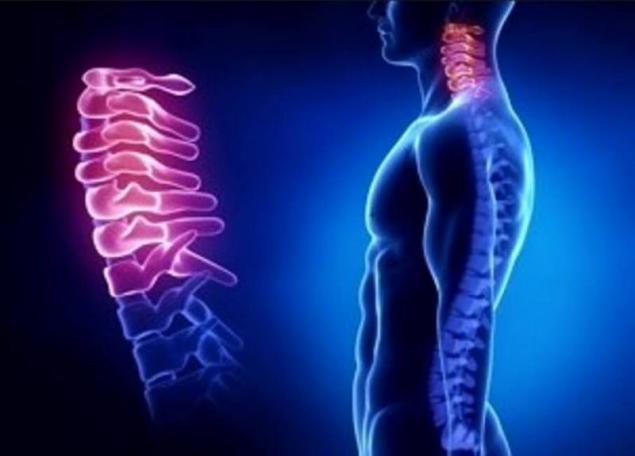
There are two ways to treat osteochondrosis:
The first way - This is the path that official medicine offers..
Drug treatment of osteochondrosis includes the appointment of such drugs:
- anti-inflammatory (NSAIDs), which are also called non-narcotic analgesics (diclofenac, nimesulide, voltaren, ketorol),
- muscle-spasmic (Tolperizon or midokalm - a muscle relaxant of central action)
The mechanism of action - blockade of H-cholinoreceptors in synapses stops the supply of a nerve impulse to skeletal muscles, and the muscles stop contracting.
- ontmicrocirculation (nicotinic acid, xanthinol nicotinate, trental, agapurin). These drugs improve the nutrition of the nerve roots and blood supply to the spine.
- antioxidants and vitamins (tocopherol, mexidol, berlithione, B vitamins). Their use accelerates the restoration of the functions of nerve fibers, improves the overall recovery processes.
On the skin in a place of severe pain, you can glue a pepper patch - this procedure warms and anesthetizes for a long time.
With very severe pain, this is not enough, and then intercostal blockades with painkillers are prescribed. Most often, a 2% solution of novocaine is used for this purpose. Since the constant presence of pain leads to excitement and fatigue of the nervous system, patients are recommended to take sedatives. The choice here is also quite wide from the tincture of valerian, motherwort, pion, to the "serious" tranquilizers prescribed by the doctor - elenium, nozepam, phenazepam.
They are also prescribed for pain relief. physiotherapy (UHF, ultraviolet radiation, electrophoresis with painkillers, etc.), courses of reflexology (point massage, acupuncture, moxibustion).
Physiotherapeutic methods of treatment of osteochondrosisFor the treatment of osteochondrosis, physiotherapy procedures are widely used, they reduce pain and swelling of tissues, improve blood circulation, stimulate muscle fixation. The type of procedure, its parameters, duration of exposure, the number of sessions are prescribed depending on the stage of the disease, the severity of pain, the main clinical manifestations, individual intolerance, age. The following methods are most often used for this purpose:
Tractional treatment of osteochondrosis (extraction treatment)
In the process of stretching, the pervertebral tissues, ligaments, muscles are stretched, as a result of which the distance between the individual vertebrae increases by 1-4 mm (on average by 1.5 mm). In the case of compression of the nerve root or blood vessels in the spinal canal of the herniated disc or osteophyte, stretching helps to reduce compression or its complete elimination, reduce swelling, normalize blood circulation. When stretching the spine, there is also a decrease in intradisc pressure, an increase in the intervertebral opening, a decrease in muscle contractures and muscle tension.
reflexology
Reflexotherapeutic effect normalizes the autonomic nervous system of the body, improves blood circulation, as well as the functioning of internal organs.
That's all. This is because we are used to someone thinking for us and giving a ready-made answer how to get out of the “wrong” state. Doctors can understand: they have a lot of them, and time for the patient is not enough. And they go down a simple path of quick pain relief and soothing for this patient. So they send him to the pharmacy. Usually the first time it helps. But after a while, the problems arise again. And, as a rule, in a more severe manifestation. But he stubbornly runs along the same route: the doctor – the pharmacy – the doctor again. The circle is closed.
Then there is either the disintegration of the body and personality, or an attempt to find another way to recovery. What?
Surgical treatment of osteochondrosis
If the patient is treated in a hospital for three to four months, various methods of treatment are used, and severe pain, curvature of the spine do not disappear, then the patient should be consulted by neurosurgeons to decide on the feasibility of the operation. About 1-3% of patients from the total number of patients with osteochondrosis of the spine undergo surgical treatment.
An example of the scheme and treatment of osteochondrosis by doctors of modern medicine
A patient comes with pain in the spine or in the joints: “Here is your sick leave.” Lie down and swallow indomethacin, in 10 days you will come, the pain should decrease. The pain in the patient really decreases, but does not go away at all, they are joined by pain in the stomach, because indomethacin very quickly damages his mucous membrane. The therapist prescribes a course of treatment, and indomethacin is forced to cancel. The neurologist directs to physiotherapy and prescribes a course of injectable vitamins, but the patient has new problems. A week later, a rash appears on the body, which is accompanied by severe itching. All drugs are canceled and the dermatologist prescribes antihistamines (against allergies) drugs.
Against the background of the abolition of painkillers, pain occurs again and does not go away with rubbing ointments and physiotherapy. And if the neurologist is forced to re-assign one of the NSAIDs (non-steroidal anti-inflammatory drugs), then there may be no allergies, the stomach may not get sick again, but, undoubtedly, there will be adverse changes in the liver and kidneys at least. And all this is payback for the removal of pain syndrome.
What happens in the body? Osteochondrosis of the spine as it was and remained, but the condition of cartilage has worsened, because NSAIDs suppress the natural processes of restoration of cartilage and the synthesis of its components. In addition, other organs and systems are under attack, because the use of drugs at any stage of the disease violates a very complex defense mechanism of the body that helps it maintain an optimal balance of the internal environment.
The consequences of this violation are unpredictable. They can manifest themselves in many years in the form of another disease, and with prolonged use of drugs - end in death.
Osteochondrosis: how to sit, stand, and lift weights
Sport and juvenile osteochondrosis
The second way is the way to relieve pain and restore the health of not only the spine, but the whole body without side effects.
One of the main commandments of Hippocrates:Eliminate the cause, the disease will go away! Forgotten by modern medicine.
It is necessary to understand that 700 muscles and 400 joints are created for a person to learn how to control his body; kilometers of vessels and capillaries running in these muscles are needed for the blood that feeds the body to run through them; and the soul for all this to feel and improve.
Hippocrates said:“Food should be your medicine and medicine your food.”.
Full-fledged natural food has always been and will be the basis for the formation of health, treatment of diseases and their prevention, and there is nothing else but to look for a way to turn modern semi-empty food into a full-fledged one. published
The materials are informative in nature. Remember, self-medication is life-threatening, for advice on the use of any drugs and treatment methods, consult a doctor.
Source: zenslim.ru/content/%D0%9E%D1%81%D1%82%D0%B0%D0%BE%D1%85%D0%BE%D0%D0%BD%D0%B4%D1%80%D0%BE%D0%B7-%E2%80%94-%D1%8D1%82%D0%BE-%D0%BD0%D0%B0%D0%B1%D0%D0%D0%B0%D0%D0%D0%B0%D0%B0%D0%B0%D0%D0%B0%D0%B0%D0%D0%B0%D0%B0%B0%D0%D0%B0%D0%B0%B0%B0%D0%D0%B0%B0%D0%D0%B0%D0%D0%B0%D0%B0%B0%B0%D0%B0%B0%D0%D0%D0%D0%B0%B0%D0%D0%B0%D0%D0%B0%D0%D0%D0%D0%D0%B0%B0%D0%B0%D0%D0%D0%D0%D0%D0%B0%B0%
Back pain is quite a frequent phenomenon in the life of each of us. But the statistics of visits to the doctor about osteochondrosis are small - only up to 20% of potential patients. As a rule, they come already when it becomes completely unbearable, although 85 percent of the world's population suffer from osteochondrosis.
As the ancients said, knowing the name of the enemy, it is easier to defeat him. And that this osteochondrosis is the enemy of the human race, no one doubts.

Osteochondrosis is a commercial diagnosis and has nothing to do with spinal pain.
As soon as they called osteochondrosis: a shot, he radiculitis, deposition of salts, or, as a due tribute to medical propaganda, acute chondrosis. Or rheumatism.
But it's not rheumatism. What then? The real name of the disease is osteochondrosis. And he's always chronic. Osteochondrosis translated from the Greek osteon means “bone”, hondros – “cartilage”, and the end of “oz” indicates the dystrophic nature of changes in these structures. You get bone and cartilage disease. The scientific definition of osteochondrosis of the spine sounds like this: osteochondrosis of the spine is dystrophic changes in the intervertebral disc and the vertebral bodies adjacent to it. Otherwise, osteochondrosis is a change caused by a violation in the disk of metabolic processes, that is, nutrition..
Osteochondrosis (Dystrophic changes in cartilage and adjacent bone) This is not a disease, but a sign of ageing. - the same as wrinkles, baldness and gray hair.
Osteochondrosis can not be the cause of back pain – bones, cartilage, spinal cord and brain do not have pain receptors. Therefore, their damage does not give pain symptoms.
Osteochondrotic growths also can neither damage nor "pinch" the roots and nerves - there are no roots outside the spinal canal, inside it they easily move into the cerebrospinal fluid, leaving compression.
In osteochondrosis, intervertebral discs - special cartilage structures that provide our spine with flexibility and mobility, become defective. That's where it starts.
There is a widespread belief that the cause of osteochondrosis is the deposition of salts in the spine: allegedly, salts are visible on X-rays in the form of “growths” and “hooks” on the vertebrae. If the movements in the joints are accompanied by crunching and creaking, as if sand is poured between them, many patients associate this with the notorious "salt deposition." Such misconceptions are by no means harmless: the correct idea of the treatment of the disease is formed on the basis of an analysis of the causes that caused it.
Causes of Osteochondrosis of a Caller
There are many theories of the development of osteochondrosis, in each of which, the main factor is one or another cause of osteochondrosis as, for example, hereditary predisposition, mechanical trauma, metabolic disorders, etc. It is especially difficult to determine the cause of osteochondrosis due to the fact that this disease occurs in both the elderly and young people, and at the same time in well-built and vice versa.

- There is an opinion that osteochondrosis of the spine is an inevitable reckoning of a person for walking upright.
But walking upright alone could not cause osteochondrosis. Osteochondrosis is accompanied by spasm and hypertonus of the spinal muscles. Muscle spasms pinch the blood vessels that feed the spine, this disrupts the blood supply and nutrition of the intervertebral discs and nerve tissues of the spinal cord and its branches. In addition, spasm muscles tighten the spine, creating an additional load on the intervertebral discs. Discs “flatten”, losing depreciation properties. Over time, this leads to the protrusion of the discs beyond the spinal column, prolapse, and then rupture of the fibrous ring, loss of the disc nucleus and the formation of an intervertebral hernia.
- Violation of normal relationships in the musculoskeletal system (congenital and acquired posture disorders, curvatures of the spine such as scoliosis and kyphosis, flat feet, pelvic distortion, different limb length, craniovertebral anomalies, etc.)
- Violation of water-electrolyte balance and mineral metabolism in the body, which negatively affects the elasticity of cartilage tissue and bone strength, reduces their resistance to static and dynamic loads.
- Development of osteochondrosis in obesity
Excess weight, which additionally pressures the spine. Against the background of excess weight, osteochondrosis of the lumbar spine most often occurs.
- A very important reason why osteochondrosis occurs is a general violation of metabolic processes in the body.
As a rule, it is associated with natural aging of the body (in particular, progressive dehydration), but it can occur at a young age.
The reason for the aging of living matter is the violation of its nutrition. It's an axiom. Remember how nutrients get into human organs and tissues. Through the arteries, blood enters the tissues, giving them oxygen and nutrients, and through the veins comes out, carrying away unnecessary metabolic products. The spine also includes arteries, and veins come out. But if blood enters the bodies of the vertebrae from the common bloodstream, then the disc - from the bodies of the vertebrae through the vessels connecting them. That is, the vertebrae are mediators in the blood supply between the discs and the entire body.
However, usually by 10-15 years there is a complete emptying of most of the vessels that connect the vertebrae to the disc.
Then the body turns on its reserve mechanisms, so that the rather intensive exchange of liquid media between them continues. But the metabolism is no longer carried out through the vessels, but through diffusion. It saves the disc, but not for long. A force is relentlessly pursuing him. The system is still working, providing power to the disk, but all with great voltage.
And then there's something that's between the disc and the vertebrae that's visibly disrupting the connection between them. This is a disaster. The pulp nucleus is breaking down. And this happens in 20-25 years. Age, look, very young.
- Development of osteochondrosis with increased physical exertion
Paradoxically, many athletes suffer from back pain, despite a good muscular corset and regular exercise.
Indeed, if the movements of the vertebrae in relation to the disc acquire a dangerously large amplitude, then in the places of their contact there are foci of traumatic injury. After all, the fibrous ring has to be restrained from excessive movement of the vertebrae. Its fibers are overstretched, sometimes torn, involving the process and edge plates. In response to damage, the body responds with inflammation.
At first, it is a transient edema of damaged tissues. In the future, as the outcome of inflammation, foci of connective, that is, scar tissue are formed in the closing plates and in the disk at the place of its contact with the vertebra.
With each traumatic movement, such scars become more and more. First one, then two, three, five... After a few years, there will be so many of them that radiologists, describing pictures of such a spine, will point to sclerosis of the closing plates.
It is the sclerosed closing plates that are the “foreign” body that closes the lumen of the vessels, and then creates an obstacle to the circulation of fluid through diffusion. Therefore, the intervertebral disc, “blocked” from above and below by sclerosed plates, gradually reborn. And here, unfortunately, no drugs or “miracle” treatments can help him. Here is a sad example of the victim of physical labor or mindless passion for sports.
Fighters with many years of experience (most of the patients with arthrosis are people over 40 years old) eventually acquire spondyloarthritis - damage to the joints of the spine, mainly in the cervical region.
For tennis players, rheumatologists even have a special term – “tennis elbow”. Due to sharp strong movements of the same type, they often suffer periarticular soft tissues of the elbow joint of the active hand.
- The development of osteochondrosis in the formation of an incorrect stereotype of body movements.
That is, because of pain or curvature of the spine, a person begins to adapt to changes, changing the gait, posture when sitting or standing. This can be observed with prolonged static load, for example, regular sitting in the wrong position, when working at a computer, when working in a forced position, when practicing certain sports, etc.
Excessive physical activity - simultaneous or constantly recurring - is especially dangerous for those who have any deviations from the norm in the structure of the supporting structures of the spine.
For the same reason, many kilometers of running is harmful - vibration, concussions, a strong increase in pressure on the articular surfaces due to the sharpness of movements. However, it is unambiguous to say that running for one kilometer - heals, and for two - already cripples, it is impossible - the physical resource of cartilage in each person is individual. But, planning a ten-twenty-kilometer Sunday run, apparently, we need to think – is it worth it?
However, physical activity is not the only mechanism that leads to malnutrition of the intervertebral disc. And we understand the irritation of supporters of an active lifestyle. Indeed, why is osteochondrosis so common in knowledge workers? Just the desk, the bills and the pen. Where does he come from - osteochondrosis? It turns out that there is a violation of metabolic processes, but only for another reason.
- Development of osteochondrosis from hypodynamia or with a sedentary lifestyle
It leads to a weakening of the muscle frame that supports the spine, and at the same time provokes stagnant phenomena in the back. As a result, blood circulation and nutrition of spinal tissues (intervertebral discs) are disturbed.

With a sedentary lifestyle, the small veins connecting the discs to the vertebrae are often clogged with clots. The danger of a sedentary lifestyle is also prolonged tension of the deep muscles of the back. What helps an office worker stay in a sitting position for several hours? What keeps his body in that position? Muscles. And above all, the deep muscles of the spine or back.
So, their prolonged tension is fraught with unpleasant consequences for the spinal column in general and for its discs in particular. Why?
Well, imagine how the intervertebral disc will feel, squeezed by the bodies of adjacent vertebrae, which are tightened by shortened muscle bundles. I think it's very uncomfortable. Moreover, vessels pass through the muscles. With prolonged muscle spasm, the existing venous stagnation will worsen even more. Due to the alternate reduction of the deep muscles of the back, the movement of venous blood from the spine occurs in the direction of the general venous vascular network.
Blood runs through the arteries thanks to a heart push, and cardiac output no longer has a significant effect on the movement of venous blood. Because the speed of blood flow is extinguished by a small network of capillaries connecting the arteries and veins. And the role of the vein pump is performed by the muscles. This is why people with inconsistency of the valves of the deep veins of the lower extremities swell their legs during prolonged sitting or, especially, standing. When walking, the swelling does not occur or is expressed much less.
Violation of venous blood flow contributes to the formation of blood clots in the veins that connect the vertebrae to the discs. As a result, the veins are empty, sclerosis. High pressure in the stagnant venous bed of the vertebral bodies prevents diffusion processes. Again, the disk power is disrupted. In addition, the constant compression of the disc by vertebrae tightened by tense muscles also makes blood flow difficult. Only in this case, the communication “disk – vertebra” is broken, and “vertebra – disc”.
Vessels do not work, diffusion processes are difficult. Nutrients do not arrive, unnecessary metabolic products are not removed from the disk. It's a nightmare. What's left for the poor disc? It's inglorious to rest. And the first “leaves” its more vulnerable part – the pulpous nucleus. That's when we start talking about the first stage of osteochondrosis.
“In addition to the above, osteochondrosis can occur against the background of spinal curvature, flatfoot, injuries and bruises of the spine, prolonged malnutrition. Therefore, all the same, osteochondrosis is a payment for improper exploitation of the body or, as it is now customary to say, for the wrong lifestyle.
Osteochondrosis is not a disease. This is the price of misunderstanding and ignorance of your own body.
Osteochondrosis is only structural changes, it is the state of the spinal column, nothing more. We call osteochondrosis a disease when its various manifestations – pain, muscle weakness, etc. – complicate a person’s life, negatively affect his performance.
Pain. It is she, being the most characteristic and often the only manifestation of osteochondrosis, significantly darkens the life of the sufferer of this disease. It is this that most often causes a person to consult a doctor. Those who suffer from pain in the spine and do not receive effective help from the attending physician are sometimes ready to grab any straw so that these sufferings only stop. Wanting to get rid of pain, a person often tries all imaginable and unthinkable types of treatment, spends a lot of time, effort and money in search of his doctor or “effective” medicine that would help him feel healthy again.
Therefore, the number of painkillers for back pain is growing, probably because the immediate relief from back pain by most specialists has become considered a cure for osteochondrosis. And although in the future there are relapses and people experiencing them are forced to wear various kinds of corsets and follow the recommendations of doctors to limit physical activity, this approach to the matter for some reason began to suit the majority. Don’t you want to get rid of this pain forever?
Of course, everyone has the desire. We want a lot out of life. We want for ourselves and our loved ones, our friends and enemies. But why aren't we doing it?
And the problem is one, little desire needs to be done. A simple thought or picture in your head cannot move you to a country house with a swimming pool or cure osteochondrosis. To do this, you need to act and not rely on a doctor only.
But you still ask, "Why did this happen?" Why am I so weak? “Because you don’t have muscle anymore.” - But I'm an athlete! Professional skier! Why did my muscles disappear? “Because you stopped skiing a long time ago.” That's how you get osteoporosis. The health of the spine largely depends on the endurance of the muscle-ligamentous apparatus or, in other words, the muscular-ligamentous corset. The stronger and more enduring the muscles and ligaments, the less stress the discs and joints take on themselves. The spine is made for movement. By not giving him that opportunity, you are stealing from yourself.
Why, most people sincerely believe that they want health, raising a glass of vodka or a glass of wine at the table at the anniversary, instead of celebrating the anniversary in the gym!
Note: the vast majority of television programs devoted to medicine and... health, take place in medical offices, in hospitals, while advertising extraordinary miracle drugs or “effective” operations. These programs do not take place in stadiums, parks, forests and fields where there is fresh air, a lot of sun and greenery. Where you want to smile, run, collect flowers, admire nature. No, they talk about health in medical offices. The word “hospital” comes from the word “pain, illness.” There are sick people in the hospital. In this small area, there are many of them, and they all talk about their diseases, and they all swallow pills and “hang” on IVs. That’s why they can’t talk about health.

There are two ways to treat osteochondrosis:
The first way - This is the path that official medicine offers..
Drug treatment of osteochondrosis includes the appointment of such drugs:
- anti-inflammatory (NSAIDs), which are also called non-narcotic analgesics (diclofenac, nimesulide, voltaren, ketorol),
- muscle-spasmic (Tolperizon or midokalm - a muscle relaxant of central action)
The mechanism of action - blockade of H-cholinoreceptors in synapses stops the supply of a nerve impulse to skeletal muscles, and the muscles stop contracting.
- ontmicrocirculation (nicotinic acid, xanthinol nicotinate, trental, agapurin). These drugs improve the nutrition of the nerve roots and blood supply to the spine.
- antioxidants and vitamins (tocopherol, mexidol, berlithione, B vitamins). Their use accelerates the restoration of the functions of nerve fibers, improves the overall recovery processes.
On the skin in a place of severe pain, you can glue a pepper patch - this procedure warms and anesthetizes for a long time.
With very severe pain, this is not enough, and then intercostal blockades with painkillers are prescribed. Most often, a 2% solution of novocaine is used for this purpose. Since the constant presence of pain leads to excitement and fatigue of the nervous system, patients are recommended to take sedatives. The choice here is also quite wide from the tincture of valerian, motherwort, pion, to the "serious" tranquilizers prescribed by the doctor - elenium, nozepam, phenazepam.
They are also prescribed for pain relief. physiotherapy (UHF, ultraviolet radiation, electrophoresis with painkillers, etc.), courses of reflexology (point massage, acupuncture, moxibustion).
Physiotherapeutic methods of treatment of osteochondrosisFor the treatment of osteochondrosis, physiotherapy procedures are widely used, they reduce pain and swelling of tissues, improve blood circulation, stimulate muscle fixation. The type of procedure, its parameters, duration of exposure, the number of sessions are prescribed depending on the stage of the disease, the severity of pain, the main clinical manifestations, individual intolerance, age. The following methods are most often used for this purpose:
- ultraviolet radiation;
- darsonvalization;
- electrophoresis of novocaine, euphyllin, lidase, bee venom preparations;
- phonophoresis of hydrocartisone;
- influence of the magnetic field;
- ultrasound;
- diadynamic currents;
- underwater shower;
- massage
- radon, sulfide, hydrogen sulfide, turpentine and other baths;
- thermal procedures;
- mud, ozokerite, paraffin applications.
Tractional treatment of osteochondrosis (extraction treatment)
In the process of stretching, the pervertebral tissues, ligaments, muscles are stretched, as a result of which the distance between the individual vertebrae increases by 1-4 mm (on average by 1.5 mm). In the case of compression of the nerve root or blood vessels in the spinal canal of the herniated disc or osteophyte, stretching helps to reduce compression or its complete elimination, reduce swelling, normalize blood circulation. When stretching the spine, there is also a decrease in intradisc pressure, an increase in the intervertebral opening, a decrease in muscle contractures and muscle tension.
reflexology
Reflexotherapeutic effect normalizes the autonomic nervous system of the body, improves blood circulation, as well as the functioning of internal organs.
That's all. This is because we are used to someone thinking for us and giving a ready-made answer how to get out of the “wrong” state. Doctors can understand: they have a lot of them, and time for the patient is not enough. And they go down a simple path of quick pain relief and soothing for this patient. So they send him to the pharmacy. Usually the first time it helps. But after a while, the problems arise again. And, as a rule, in a more severe manifestation. But he stubbornly runs along the same route: the doctor – the pharmacy – the doctor again. The circle is closed.
Then there is either the disintegration of the body and personality, or an attempt to find another way to recovery. What?
Surgical treatment of osteochondrosis
If the patient is treated in a hospital for three to four months, various methods of treatment are used, and severe pain, curvature of the spine do not disappear, then the patient should be consulted by neurosurgeons to decide on the feasibility of the operation. About 1-3% of patients from the total number of patients with osteochondrosis of the spine undergo surgical treatment.
An example of the scheme and treatment of osteochondrosis by doctors of modern medicine
A patient comes with pain in the spine or in the joints: “Here is your sick leave.” Lie down and swallow indomethacin, in 10 days you will come, the pain should decrease. The pain in the patient really decreases, but does not go away at all, they are joined by pain in the stomach, because indomethacin very quickly damages his mucous membrane. The therapist prescribes a course of treatment, and indomethacin is forced to cancel. The neurologist directs to physiotherapy and prescribes a course of injectable vitamins, but the patient has new problems. A week later, a rash appears on the body, which is accompanied by severe itching. All drugs are canceled and the dermatologist prescribes antihistamines (against allergies) drugs.
Against the background of the abolition of painkillers, pain occurs again and does not go away with rubbing ointments and physiotherapy. And if the neurologist is forced to re-assign one of the NSAIDs (non-steroidal anti-inflammatory drugs), then there may be no allergies, the stomach may not get sick again, but, undoubtedly, there will be adverse changes in the liver and kidneys at least. And all this is payback for the removal of pain syndrome.
What happens in the body? Osteochondrosis of the spine as it was and remained, but the condition of cartilage has worsened, because NSAIDs suppress the natural processes of restoration of cartilage and the synthesis of its components. In addition, other organs and systems are under attack, because the use of drugs at any stage of the disease violates a very complex defense mechanism of the body that helps it maintain an optimal balance of the internal environment.
The consequences of this violation are unpredictable. They can manifest themselves in many years in the form of another disease, and with prolonged use of drugs - end in death.
Osteochondrosis: how to sit, stand, and lift weights
Sport and juvenile osteochondrosis
The second way is the way to relieve pain and restore the health of not only the spine, but the whole body without side effects.
One of the main commandments of Hippocrates:Eliminate the cause, the disease will go away! Forgotten by modern medicine.
It is necessary to understand that 700 muscles and 400 joints are created for a person to learn how to control his body; kilometers of vessels and capillaries running in these muscles are needed for the blood that feeds the body to run through them; and the soul for all this to feel and improve.
Hippocrates said:“Food should be your medicine and medicine your food.”.
Full-fledged natural food has always been and will be the basis for the formation of health, treatment of diseases and their prevention, and there is nothing else but to look for a way to turn modern semi-empty food into a full-fledged one. published
The materials are informative in nature. Remember, self-medication is life-threatening, for advice on the use of any drugs and treatment methods, consult a doctor.
Source: zenslim.ru/content/%D0%9E%D1%81%D1%82%D0%B0%D0%BE%D1%85%D0%BE%D0%D0%BD%D0%B4%D1%80%D0%BE%D0%B7-%E2%80%94-%D1%8D1%82%D0%BE-%D0%BD0%D0%B0%D0%B1%D0%D0%D0%B0%D0%D0%D0%B0%D0%B0%D0%B0%D0%D0%B0%D0%B0%D0%D0%B0%D0%B0%B0%D0%D0%B0%D0%B0%B0%B0%D0%D0%B0%B0%D0%D0%B0%D0%D0%B0%D0%B0%B0%B0%D0%B0%B0%D0%D0%D0%D0%B0%B0%D0%D0%B0%D0%D0%B0%D0%D0%D0%D0%D0%B0%B0%D0%B0%D0%D0%D0%D0%D0%D0%B0%B0%
